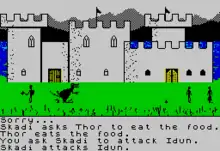Valhalla (video game)
Valhalla is an adventure game published in 1983 by the British studio Legend. It was originally made for the ZX Spectrum, but the game was later ported to the Commodore 64 in 1985.[1]
| Valhalla | |
|---|---|
| Developer(s) | Legend |
| Publisher(s) | Legend |
| Platform(s) | ZX Spectrum, Commodore 64 |
| Release | 1983 |
| Genre(s) | Adventure, interactive fiction |
| Mode(s) | Single player |
Gameplay

Valhalla is an adventure game, in which characters move through various Nordic locations with accompanying text at the bottom of the screen detailing all character actions. It is set mainly in Asgard and Midgard, though when the character dies, it reappears in Hell (Niflheim under another name) and is able to walk out.
The game's text parser understands most multi-part sentences, as long as they are written using the words listed in the manual. Listing the accepted words was not seen in most similar titles of the time.
The aim is to collect six mythical objects: Ofnir (key), Drapnir (ring), Skornir (shield), Skalir (sword), Felstrong (axe), and Grimnir (helmet). To obtain all the items, the player receives help from various characters from Norse mythology. If the player dies while holding any of the six items, it will be lost and moved to a new location.[2] These objects are required to access otherwise unreachable parts of the game, such as Valhalla, however carrying any of the items saps the player's strength.
The character has an alignment (between good and evil) that changes depending on which of the other characters are helped. The more the player helps good characters, the more other good characters will help the player in their quest. Characters include gods, goddesses, dwarves, dragons, wolves, a snake, and a raven.[3]
The characters move and interact independent of any action by the player. If the player does nothing, the game 'plays' itself, with the characters moving about while the player decides what to do.[1]
Typing in a swear word causes a dwarf to dash onto the screen to punch the player while generating the message "Mary is not amused....". Mary can be found in El Vinos and even if killed, she returns within a minute.
The game engine has a limit of eight objects to be left in any one location, whether on the ground, in a chest, or in a cupboard. If the player drops an object in an area where the limit has been reached, a character called Klepto appears to steal the item, removing it from the game.
Development
The publishing house Legend had published earlier titles under the MiCROL label. Legend's founder and chairman at the time of release was John Peel.[1] The developers were Richard Edwards, Graham Asher, Charles Goodwin, James Learmont, and Andrew Owen. The original game was released in English for the Sinclair Spectrum 48K computer. The MOViSOFT graphics engine occupied 4K of the game footprint and used machine code, with the rest of the game engine and text parser written in Sinclair BASIC.[4] After its successful launch in the UK, the game was then ported to the Commodore 64, with pirated editions appearing in Spanish.
Cultural references
The cover of the game, as well as the loading screen, features a drawing of the Sutton Hoo helmet, an artifact from the 7th century believe to have belonged to King Rædwald of East Anglia. The helmet was found in an Anglo-Saxon burial site at Sutton Hoo, Suffolk, UK.
References
- "Valhalla – Hardcore Gaming 101". Retrieved 2020-07-02.
- "Valhalla for Commodore 64 (1984)". MobyGames. Retrieved 2020-07-02.
- https://worldofspectrum.org/pub/sinclair/games-info/v/Valhalla.txt — the list of characters and their types is quite a long way down
- House, © Future Publishing Limited Quay; Ambury, The; Engl, Bath BA1 1UA All rights reserved; number 2008885, Wales company registration. "Valhalla | Retro Gamer". www.retrogamer.net. Retrieved 2020-07-02.
External links
- Review from Sinclair User issue 23, February 1984; at Sinclair User Magazine Online
- Valhalla at SpectrumComputing.co.uk